For our final piece our group has made a short social realist film, focusing particularly along the storyline of a broken family, one of the key conventions to British social realist films.
In pre-production research we found that British Social Realist films follow a similar structure in their conventions, helping them to be placed into this genre. British Social Realism films first became popular after WWI where it was discovered that the “key” to national cinema was found in realism and the seriousness they conveyed, becoming current themes associated with the genre today. Other notable conventions were mainly relying on diegetic sounds, using natural lighting, mainly focusing on the working class, and using as many “normal” props and settings as possible to convey the realism.
In what ways does my media product use, develop or challenge forms and conventi ons of real media products?
ons of real media products?
• When first looking in to social realism, one of the first films I looked at independently was “London to Brighton” a modern social realism film directed by Paul Andrew Williams. One of the key things I noticed in this film which directly related it to social realism was the actual theme. Addressing the issue of drugs, prostitutes, and homeless children.
• Having looked at this film combined with others such as Happy Go Lucky (Mike Leigh)/http://www.imdb.com/title/tt1045670/ and Wasp (Andrea Arnold) http://www.imdb.com/title/tt0388534/ there seemed to be a pattern in which the themes all conformed to, they all dealt with “harsh” topics and did not try to glamorize it.
• Another convention noted in all the films above were the fact that they  were all representing working-class people, and not middle-class. For example this was instantly noted in Happy Go Lucky where we are introduced to this young care free teacher, sharing a flat with her best friend in North London. In Wasp it was much more obvious as we are shown an establishing shot of the council estate of which a single mother with 4 children is living in.
were all representing working-class people, and not middle-class. For example this was instantly noted in Happy Go Lucky where we are introduced to this young care free teacher, sharing a flat with her best friend in North London. In Wasp it was much more obvious as we are shown an establishing shot of the council estate of which a single mother with 4 children is living in.
• In our film we decided to break this convention of social realism, and chose to use a middle-class family, although not struggling financially, still breaking up as a family unit and trying to cope with an alcoholic/abusive father. This I felt worked quite well as I still think people can connect and empathise with our main character Milo, regardless of the fact he is from a middle-class background.
• The colour we found in most of these social realist films seemed to be desaturated, which fits in with the genre and helped to match the themes presented, giving them a gritty feel and reinforced the despair of our central character. Here is a still from our film having used the desaturated colour. Here is an example of a still from our film showing the effect of the desaturated colour.
• Following on from the use of colour another typical convention for the genre is relying on the use of natural lighting, which we managed to do throughout our film. However for the scene in the bedroom where we needed it to be quite dark we had to use artificial lighting. The effect of having the natural lighting helped to support the fact that this film is based on reality, and we didn’t want any special effects, including enhanced lighting.
• The choice of using a young boy as our main character we made quite early on. Many social realist films tended to be about slightly older people, usually teenagers or late 20’s to early 30’s. The reason for this being that we wanted to break away from this mould which had been made by the genre, but also because an audience can always relate to a child because we have all been one.
• Having found inspiration for this in London to Brighton as mentioned previously where one of the lead protagonists is a young girl, but also having watched Mixtape, a short film by Luke Snellin. Here is the link to watch this - http://www.youtube.com/watch?v=exFWurXtsU4
Another film which we found directly related to our original idea was Eight (Stephen Daldry) the plot being this young boy who is trying to come to terms with the loss of his father.
• The usage of props was very limited in our short film, as anything which would appear out of the ordinary would not fit in with the genre of social realism. During our rushes we attempted to create a scene where we had Milo tiptoeing around bottles, which we had to remove as the whole scene appeared far too staged and did not look appropriate in its surroundings. I think one of our best shots whilst using the props is the scene where the mother and father come arguing through the door and the bottle is lying on the floor and gets smashed. This combined with the establishing shots of the bottles placed along the fireplace instantly set the tone for our film, and helps to emphasise the key issue we explored. Here is an example o f the stills from our film.
f the stills from our film.
• One of the main techniques in editing of social realism is the use of straight cuts. This helps to keep the continuity; however when we were changing location in our film or time periods we used fades such as the scene where we have an ELS of Milo jumping on the trampoline in the garden and then it turning into night. Combined with the use of the sound bridges using diegetic and non diegetic sound this helped to keep the continuity without confusing our audience. The most effective use of the sound bridge is right at the beginning where you see the shot of the bird outside appearing very peaceful, and then the parents arguing contrasting this in the background. The uses of juxtaposing these 2 scenes I think helps shock the audience, and help them to sympathise with Milo’s situation. Example of the fade to the right. Another type of shot we used frequently was the use of the match on action, again emphasizing the continuity.
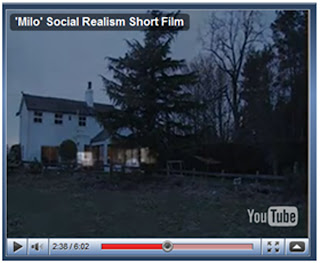
• I think we have managed to conform to most of the social realism conventions, although challenging them in some areas such as our setting and the social class of our family. The overall effect of this being is that not only working class people from less affluent areas experience family difficulties in their lives, and we wanted to portray this which I think we did successfully.
Inspirational Directors
• When researching into the genre of social realism initially there were a few directors who seemed to specialise in it. Andrea Arnold who directed Wasp as mentioned previously
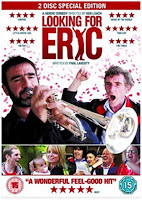 also had a recent award winning release of another social realism film Fish Tank. Many of her films show things from a women’s perspective and all seem to follow a female lead.
also had a recent award winning release of another social realism film Fish Tank. Many of her films show things from a women’s perspective and all seem to follow a female lead.• Ken Loach known for being quite pessimistic in his outlook on life is known for directing many social realist films. In his film Looking for Eric, made in 2009 we follow the story of a man who’s life is descending into crisis, being a single parent to stepsons and juggling this with trying to be the breadwinner as well. However this is deviating from the norm of having a single mother, the film still displays key social realist conventions.
Narrative Structure
• Todorov established a narrative structure in which an equilibrium is set up which is then disrupted, causing disequilibrium which then can be resolved. I believe our short film fits into this as we are first introduced to our characters situation which we then realise has become disrupted, by use of the parents crashing through the front door. As the film continues it becomes obvious to the audience that Milo is beginning to understand and question what is going on around him, recognising his family circumstance is not ideal. Although Milo cannot do anything to resolve the situation the end seems to have a happier outcome as although the family unit is broken, the outcome is a more comfortable and stable environment.
How effective is the combination of your main product and your ancillary tasks?
• The review- I think that overall the review works really well. After studying the magazine LittleWhiteLies of which our review would theoretically appear in we had to come to terms with the language used and how to phrase our own work. Having looked at other previous reviews for the magazine such as http://www.littlewhitelies.co.uk/theatrical-reviews/kick-ass/ and http://www.littlewhitelies.co.uk/theatrical-reviews/precious/ it became evident that their approach was informal, direct and straight to the point. They gave an honest review, good or bad and rarely used complex film language and so it would be easy to understand having not studied Media or Film. They also used an interesting rating system which is further explained here: http://www.littlewhitelies.co.uk/theatrical-reviews/eviews/. They would rate the film out of one of three categories being, Anticipation, Enjoyment and In Retrospect each one summed up in one short snappy sentence at the end of each review. It became evident that LittleWhiteLies was a very art based magazine and relied heavily on the layout so we also wanted to make ours as visually stimulating as they did in the actual magazine. Here are a few examples of their layouts:
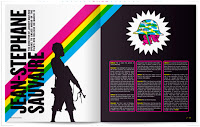
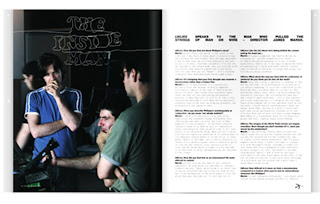 We also noted that the magazine would dedicate a whole issue to one film and so in addition to our review seen here: http://advancedportfoliolloyd.blogspot.com/2010/04/final-review-alex-lloyd-abi-black.html Jack Storer also created a Credits Page http://advancedportfoliolloyd.blogspot.com/2010/03/credits-little-white-lies-jack-storer.html for the magazine, using alcohol bottles representing our film.
We also noted that the magazine would dedicate a whole issue to one film and so in addition to our review seen here: http://advancedportfoliolloyd.blogspot.com/2010/04/final-review-alex-lloyd-abi-black.html Jack Storer also created a Credits Page http://advancedportfoliolloyd.blogspot.com/2010/03/credits-little-white-lies-jack-storer.html for the magazine, using alcohol bottles representing our film.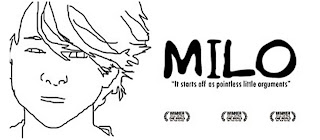
Caroline then went on to further develop this initial idea for the poster by introducing some colour. We also chose to use the most memorable and iconic image in the film, of Milo in the foreground in focus whilst his parents are in the background arguing. I think this picture is very powerful and significant to our film and so helps to set the tone for what’s to come in the film. Here is Caroline’s first development of this.
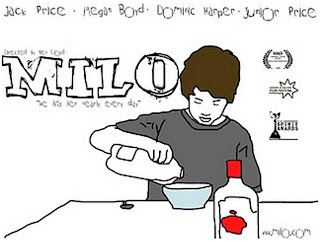
• The effect of having Milo in darker colours and all the text co-ordinating with this helps the vivid red on the vodka bottle to stand out, reinforcing our theme of a child coping with alcoholism in his life.
• I think that the combination of the review and the poster help to back up and support our short film, which I found to be one of the most enjoyable tasks we have done.
What have you learnt from your audience feedback?
• We set the target audience for our film to be roughly from the age of 12+ and decided it could be enjoyed by anyone from any social class background.
• We chose to get a range of people to review our film, using Facebook and Youtube. We decided to do this as many people now use social networking sites as a way of communicating and it allowed us to send our work to a whole range of people.
• Here are some examples of audience feedback we received;
“The innocence of the little kids voice really suits the narrative” Charlie Izard, 17
“I liked how the voice continued over the top of everything as it allows you to hear what is going on in this boys head and creates a connection between him and the audience as you feel like he is confiding in you. The monologue was very well written as it sounded like what a child would actually say in that situation, and not too dummed down” Katy Black, 20
“This is so good, I love how the child narrates it” Evie Chandler, 13
• I think all these comments show that we made a good decision to use the monologue over the top of everything. Not only does it help the audience to connect with the protagonist but it also helps to create continuity, keeping the momentum.
• Another scene which we got positive feedback on was the one in where it cuts from an EL establishing shot of the home, to the bottle smashing on the floor. I think this helps the audience to engage with what is happening in this little boy’s life but also creates tension. The tension is then broken as it switches to a contrasting slow motion scene of Milo on the trampoline.
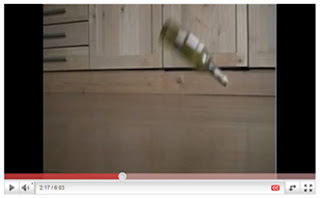 • I think one of the main criticisms we got from our audience feedback which I also think we could have improved on was that the end transition was a bit rushed and we could have taken a bit more time to allow it to happen. However overall the end shot also had positive feedback;
• I think one of the main criticisms we got from our audience feedback which I also think we could have improved on was that the end transition was a bit rushed and we could have taken a bit more time to allow it to happen. However overall the end shot also had positive feedback;“The way it links back to the first shot as well, with the child eating breakfast and then changes into the older guy is brilliant” Lucy Boakes, 17
• Here is a link to other audience feedback given: http://advancedportfoliolloyd.blogspot.com/2010/04/further-audience-feedback-caroline.html
How did you use new media technologies in the construction and research, planning and evaluation stages?
• Throughout our production we have all been developing our skills by experimenting using different digital technologies, our first decision being the Sony HD camera. As we had previously decided we wanted our film to have a wide screen format the Sony HD w
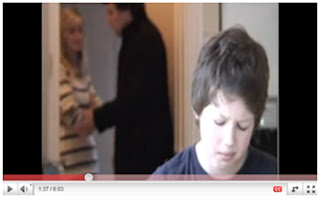 as the camera best suited to do so, however at times where this was not available to us we used the MX2 instead.
as the camera best suited to do so, however at times where this was not available to us we used the MX2 instead.• One of the main advantages of having the Sony HD was that it allowed us to use manual focus, which proved very effective when we wanted a short depth of field allowing the audience to focus on Milo. Example of this to the right.
• Although Alex did the majority of the filming, we all had a go at using the camera in which I took the panning shots of the fireplace at the beginning of the film.
This camera also allowed us to use slow motion, which can be quite difficult to achieve in post production. I think the slow motion scene on the trampoline is one of my favourite scenes as it shows Milo’s attempt to escapism, contrasting with the previous scene of the bottle smashing to the floor. (Slow Motion scene starting at 2:18)
• Using Final Cut Pro gave us the advantage of changing the saturation of our film, to match the desaturated tones we had seen displayed in other social realist films. It also allowed us to easily add in our soundtrack made by Caroline using Garageband, which I think combined with other follies helped to really polish our film off.
• Having used Blogger.com before from the previous project I had a basic understanding of how to use it. However this year we have all used the blog much more, as a way of communicating ideas, showing evidence of research and planning.
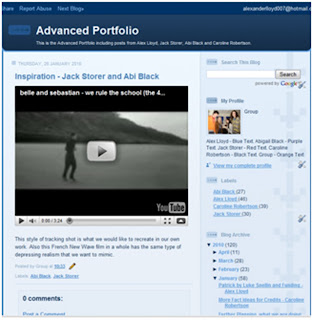
• Using blogger allowed us all to see where each other was at in terms of progress throughout the project, but also gain inspiration and knowledge from what the other person had wrote.
• Last year we mainly used the blog just to write on but this year we have used it much more to import images, use htmls and video links. Example of using a video link:
• Finally one of the last forms of technology we used was Photoshop and InDesign. Adobe Photoshop was extremely useful throughout creating the poster and editing the review. With a vast range of tools it allowed us to manipulate our image, change the saturation and contrasts and so was an obvious choice when it came to creating our final review and poster.
Overall I found the genre of social realism a very enjoyable one to re create and I found that our group worked well as a team. If we were to do this again I would perhaps organise our time better as it was hard to all meet up to film due to prior engagements but also to get our lead actor, Junior Price, free at the same time as well.





